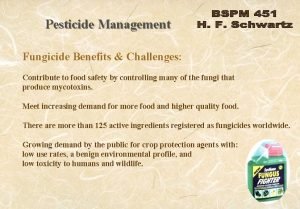Effects of foliar fungicide application on the growing

- Slides: 1

Effects of foliar fungicide application on the growing corn plant K. Robinson 1, C. Kalebich 1, G. M. Fellows 2, and F. C. Cardoso 1 1 Department of Animal Sciences, University of Illinois, Urbana; 2 B. A. S. F. Corporation, Research Triangle Park, NC USA 27709 ABSTRACT The objective was to evaluate the health and growth of corn plants after application of foliar fungicide. Treatments were replicated once and randomly assigned to eight, one-acre plots: CON, no foliar fungicide application; V 5, one application of pyraclotrobin foliar fungicide at corn vegetative growth stage V 5; R 1, one application of pyraclostrobin and metconazole foliar fungicide at corn reproductive growth stage R 1; and V 5+R 1, one application of pyraclotrobin foliar fungicide at V 5 and one application of pyraclostrobin and metconazole foliar fungicide at R 1. Measurements were recorded at R 1 and R 3 growth stages from two locations within each replicate. At R 3, a 24. 7% of disease incidence in plants evaluated showed symptoms of Grey Leaf Spot. Treatment V 5 at R 3 was most effected by Grey Leaf Spot (15%). Northern Leaf Blight was also found in the field, the highest percentage of disease incidence being in CON (10%) and least disease incidence in V 5+R 1 (1. 63%). There was no difference (P=0. 52) in the weight of the plants. Applications of foliar fungicide increased the average heights (P<0. 0001). Applications of foliar fungicide at V 5, R 1, and V 5+R 1 decreased the number of yellow leaves (P=0. 0018). Applications of foliar fungicides increased plant health, and may contribute to a higher quality feedstuff. METHODS INTRODUCTION • 8 one-acre plots of corn were planted in 2015. Treatments were replicated 1 X and randomly assigned to one of the plots. • CON, no foliar fungicide application • V 5, 1 application of pyraclostrobin foliar fungicide at corn vegetative growth stage V 5 • R 1, 1 application of pyraclostrobin and metconazole foliar fungicide at corn reproductive growth stage R 1 • V 5+R 1, 1 application of pyraclostrobin foliar fungicide at V 5 and 1 application of pyraclostrobin and metconazole foliar fungicide at R 1 • Measurements of height and weight were recorded at R 1 (the silking stage) and R 3 (the kernel milk stage) for six individual corn plants per row from two locations within each replicate at both time points. • The same plant’s leaves, corn cobs, and stalks were assessed and collected at R 1 and R 3. • Composited samples of corn cobs, stalks, leaves, and flag leaves were sent to a commercial labs to undergo further analysis: - Crude protein, lignin, ADF, NDF, starch, and water soluble CHO tests, and mineral analysis. • Fungal diseases have the potential to decrease yields and quality of the corn plant. • In 2007, approximately 4. 3 to 5. 6 million ha out of 30. 8 million ha of corn in the Midwest were sprayed with a foliar fungicide. • University of Wisconsin Extension study found corn treated with fungicide yielded 0. 7 tons more in silage dry matter and an 1. 9% increase in starch content. • Included in diets at 50 -70 lbs of wet corn silage per cow per day. • Corn silage is highly digestible and palatable and only requires harvesting once-a-year. • In a previous study, cows receiving corn silage treated with foliar fungicide had better feed conversion of dry matter to milk than those receiving the CON corn silage. RESULTS Corn Cob Composition Corn Flag Leaf Composition 70 35 60 30 50 25 40 20 CP ADF NDF 30 ADF % of DM CP NDF Lignin 15 Lignin Starch WSC 20 ab a bc Crude fat 10 c 5 10 0 CON V 5 V 5+R 1 R 1 Corn Leaf Composition Corn Stalk Composition 70 80 60 a ab 70 bc d 50 60 % of DM CP % of DM ADF NDF 40 ADF 40 CP 50 a NDF ab 30 Lignin abc d Lignin Starch WSC 30 Crude Fat 20 10 10 ab b a abc ab c 0 CON V 5+R 1 0 V 5+R 1 8 7, 5 7 6, 5 6 5, 5 5 4, 5 4 3, 5 3 Corn Leaves Treatment * Time point Corn Leaves TRT*TP 65 38 CON V 5/R 1 R 1 R 3 Cellulose, % of DM Lignin, % of DM Corn Stalks Treatment x Time Point CON 33 V 5 28 V 5+R 1 23 P < 0. 03 R 1 Corn Leaves, Treatment*Timepoint 60 CON 55 V 5 50 V 5/R 1 45 R 1 40 P < 0. 068 18 R 1 R 3 P < 0. 02 ADF, % of DM, log transformed V 5 % a. NDF, of DM CON 3, 6 3, 5 CON 3, 4 V 5 3, 3 V 5+R 1 3, 2 R 1 3, 1 P < 0. 008 3 R 1 CONCLUSIONS In conclusion, our results showed that foliar fungicide had the greatest effect on the leaves of the plant. Fungicide treatments had a significant effect on leaves’ ADF as a percent of dry matter (P=0. 01) and a significant effect on NDF as a percent of dry matter(P=0. 02). Cellulose and Na as percentages of dry matter were also affected by applications of foliar fungicides (P=0. 01 and P=0. 01, respectively). The results of this study have implications that fungicide applications can affect nutrient status in the plant. More research is needed to see how it affects plant digestibility, animal performance, and in-silo environment. In future studies, a more clear design would allow us to examine the effects of foliar fungicide application on the growing corn plant. It would also be valuable to perform soil sampling, increase sample size, and to test the effect that fungicide application has on ensiled corn silage. REFERENCES • Blonde, G. , P. Esker. 2008. The Effect of Headline Foliar Fungicide on Corn Silage Yield and Quality Forage Focus. • Bradley, C. A. , and Ames, K. A. 2010. Effect of foliar fungicides on corn with simulated hail damage. Plant Dis. 94: 83 -86. • Haerr, KJ, NM Lopes, MN Pereira, GM Fellows, and FC Cardoso. "Corn Silage from Corn Treated with Foliar Fungicide and Performance of Holstein Cows. " J Dairy Sci 98. 12 (2015): 8962 -972. Web. • Mahanna, Bill. 2005. Managing Corn Silage from Seed to Feed. R 3 ACKNOWLEDGEMENTS I would like to thank Caroline Kalebich, Dr. Cardoso, and Maegan Weatherly for all of their help! I would also like to thank the Dairy Focus Lab Group, the University of Illinois Animal Sciences Department, and the University of Illinois Office of Undergraduate Research.

